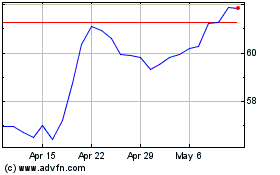Five Things to Watch in Bank Stress Tests
June 22 2017 - 10:25AM
Dow Jones News
By Aaron Lucchetti
It's final exam time again for the nation's largest banks. The
two-part stress test of U.S. lenders is set to kick off Thursday
with an industrywide checkup of who would best handle a
hypothetical period of market turmoil.
Started after the financial crisis and administered by the
Federal Reserve, the stress tests have evolved as banks boosted
capital dramatically. But they still serve as a warning to
regulators about banks that might face problems if economic
conditions worsen significantly.
Here are five things to watch for this week as the Federal
Reserve prepares to publish its findings.
1. Payout Ratios Expected to Rise Again
The biggest reason investors care about this month's stress
tests: it determines how big their banks' dividend will be for the
next 12 months. This is determined by the second part of the tests,
which will be made public on June 28. After the financial crisis,
many banks scaled back their dividend and couldn't boost it again
until regulators were confident the bank held enough capital. The
same restraint applied to share buybacks, another
shareholder-friendly gesture that makes regulators nervous because
it depletes a bank's capital. In recent years, the Fed has given
banks permission to increase buybacks and dividends, in some cases
beyond 100% of their net income.
2. Big Stakes for Two Big Banks
Citigroup Inc. and Bank of America Corp. are hoping for a
stress-free test. New-York-based Citigroup and Charlotte-based Bank
of America have the lowest price-to-book ratios of America's large
banks. In part, that reflects concerns about their strategies and
past missteps that led to big losses. The banks have been
challenged to increase dividends and buybacks. Citigroup failed the
Fed's stress tests in 2012 and 2014, while Bank of America was
criticized in the 2015 test for internal-control weaknesses after
disclosing a costly error on the 2014 test.
3. Focus on Real Estate
Each stress test drills down into different potential problems
with the economy. This is disclosed ahead of time and factored into
the both parts of the test. This year, the Fed is presenting
lenders with scenarios that include 10% unemployment, a recession
in Europe and a sharp drop in housing prices. It's also watching
commercial real estate, which some believe has gotten extended and
risky as the post-crisis economic expansion ages. The sector has
faced added concerns due to the persistent problems retailers have
faced dealing with online competitors such as Amazon.com Inc.
4. Some Banks Get a Pass
In one way, the test will be easier this year for a significant
number of big banks. The Fed announced earlier this year that 21
firms with "less complex operations" will no longer be subject to
the qualitative portion of the second part of the test, known as
the Comprehensive Capital Analysis and Review, or "CCAR." This part
of the test, which will still be applied to 13 of the largest
banks, has been criticized over the years for being unpredictable
and subjective. Regulators have said that the qualitative test was
more important as banks got used to taking the stress test and for
those giant institutions like J.P. Morgan Chase & Co. whose
failure would cause systemic problems globally.
5. Does Wells Fargo End Well? It's been a rough stretch for the
third largest U.S. bank by assets. In September, Wells Fargo
settled civil charges with federal regulators over allegations
employees created as many as 2.1 million phantom retail accounts.
Then, its CEO left, regulators rebuked the bank over its "living
will" contingency plan, and in March, the bank suffered a downgrade
of its Community Reinvestment Act rating. The bank has been working
to clean up its problems, but some investors fear there's one more
rebuke to come with this year's stress test.
Write to Aaron Lucchetti at aaron.lucchetti@wsj.com
(END) Dow Jones Newswires
June 22, 2017 10:10 ET (14:10 GMT)
Copyright (c) 2017 Dow Jones & Company, Inc.
Wells Fargo (NYSE:WFC)
Historical Stock Chart
From Mar 2024 to Apr 2024

Wells Fargo (NYSE:WFC)
Historical Stock Chart
From Apr 2023 to Apr 2024
